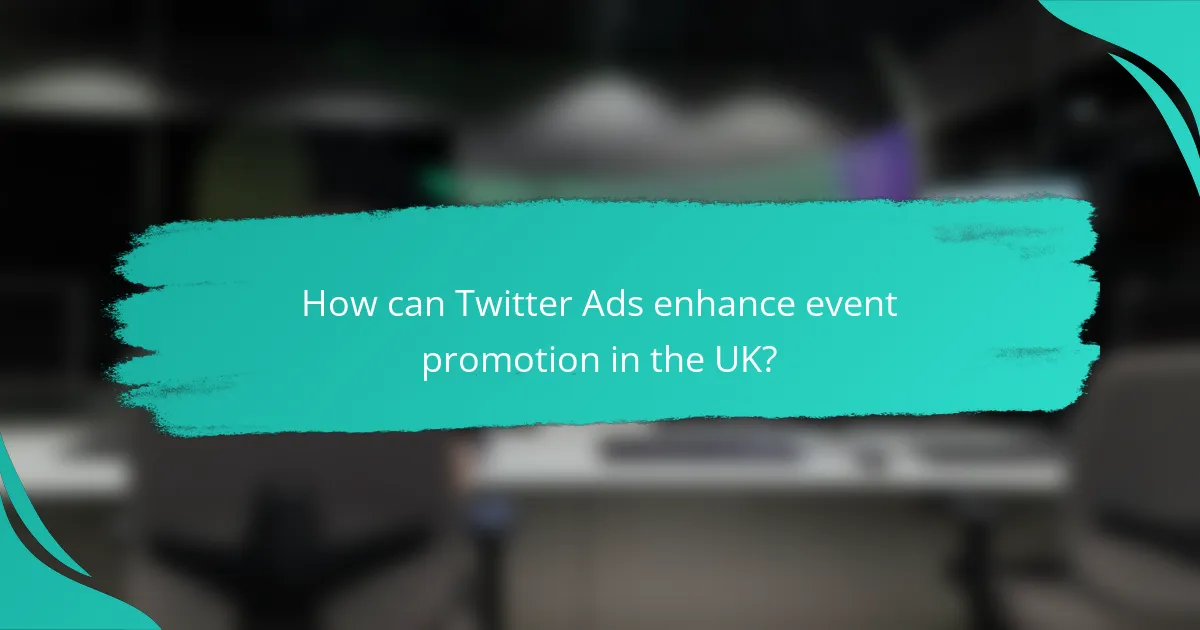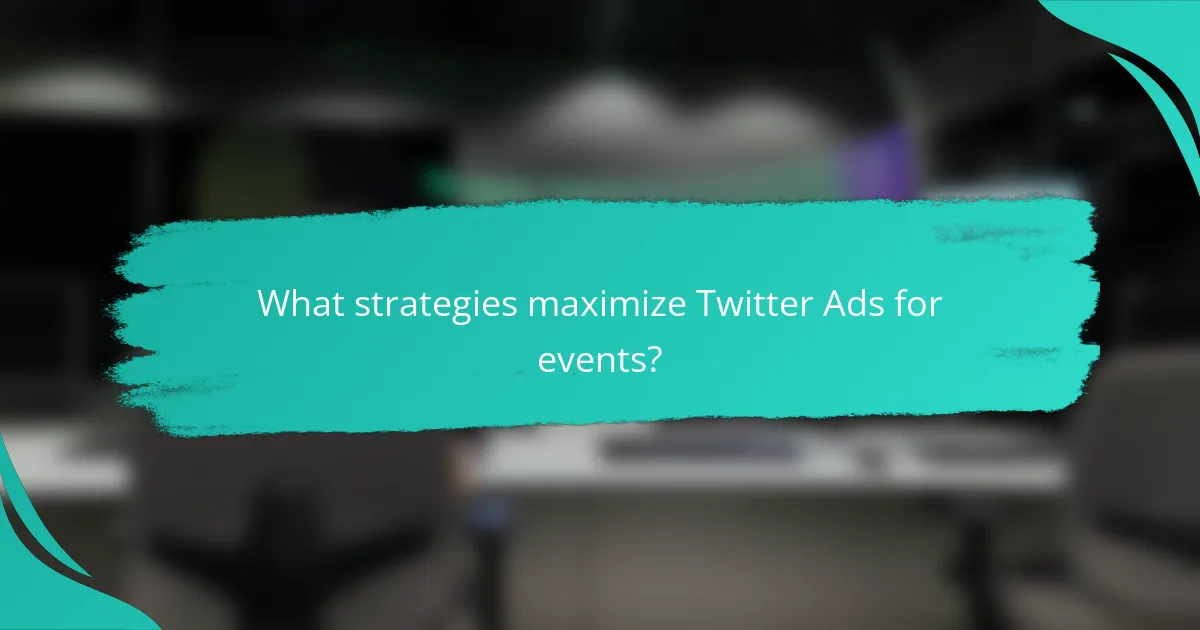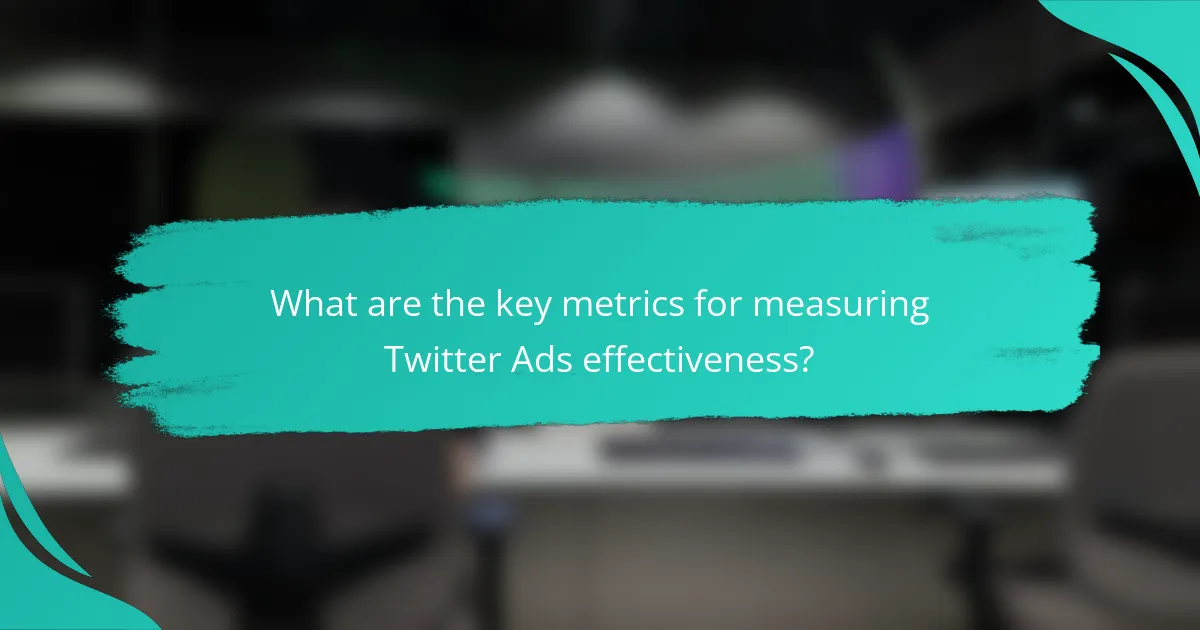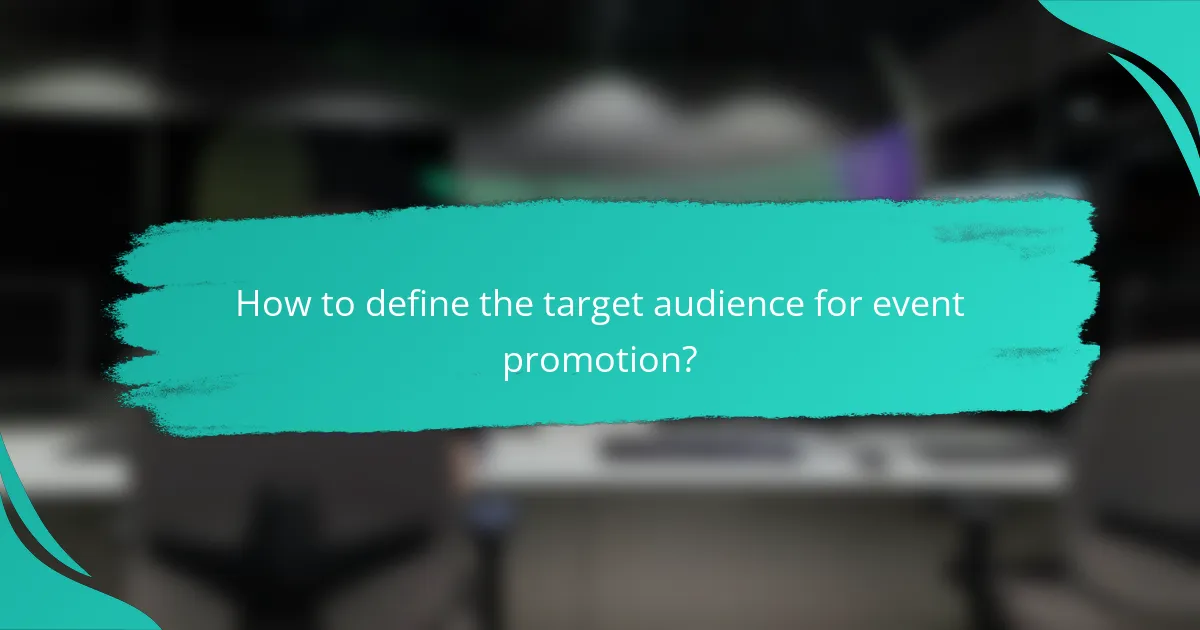Twitter Ads serve as a powerful tool for event promotion, enabling organizers to reach a specific audience while fostering real-time engagement. By leveraging tailored campaigns, compelling visuals, and strategic hashtags, event marketers can enhance visibility and drive attendance. Monitoring key metrics such as click-through rates and engagement rates is essential for assessing the effectiveness of these advertising efforts.

How can Twitter Ads enhance event promotion in the UK?
Twitter Ads can significantly boost event promotion in the UK by reaching a targeted audience and facilitating real-time engagement. This platform allows event organizers to create tailored campaigns that resonate with potential attendees, maximizing visibility and interaction.
Targeted audience reach
Twitter Ads enable precise targeting based on demographics, interests, and behaviors, ensuring that promotional content reaches the most relevant users. For instance, event organizers can target individuals interested in specific topics or those who follow similar events, increasing the likelihood of engagement.
Utilizing Twitter’s audience insights, marketers can refine their campaigns to focus on users in specific locations, such as major UK cities like London or Manchester, enhancing local relevance and attendance rates.
Real-time engagement opportunities
One of the key advantages of Twitter Ads is the ability to engage with audiences in real-time. During an event, organizers can use Twitter to share live updates, respond to attendee inquiries, and encourage user-generated content through hashtags.
This immediate interaction fosters a sense of community and excitement, making attendees feel more connected to the event and encouraging them to share their experiences, further amplifying the event’s reach.
Cost-effective advertising solutions
Twitter Ads offer flexible budgeting options, allowing event promoters to set daily or total campaign budgets that suit their financial constraints. This makes it accessible for both large and small events to utilize the platform effectively.
Additionally, the pay-per-click model means that advertisers only pay when users engage with their ads, making it a cost-efficient way to drive interest and attendance without overspending.
Analytics for performance tracking
Twitter provides robust analytics tools that allow event organizers to track the performance of their ad campaigns in real-time. Metrics such as impressions, clicks, and engagement rates can help assess the effectiveness of different strategies.
By analyzing this data, marketers can make informed adjustments to their campaigns, optimizing for better results and ensuring that promotional efforts are aligned with audience preferences and behaviors.

What strategies maximize Twitter Ads for events?
To maximize Twitter Ads for events, focus on targeted audience engagement, compelling visuals, and strategic use of hashtags. These elements can significantly enhance visibility and interaction, driving attendance and interest.
Utilizing hashtags for visibility
Hashtags are essential for increasing the visibility of your event on Twitter. By using relevant and trending hashtags, you can reach a broader audience beyond your followers. Aim for a mix of general event-related hashtags and specific ones that relate directly to your event’s theme.
Consider creating a unique hashtag for your event to encourage attendees to share their experiences. This not only boosts engagement but also helps in tracking conversations related to your event.
Creating engaging visual content
Visual content, such as images and videos, can significantly enhance the effectiveness of your Twitter Ads. Posts with visuals are more likely to be shared and engaged with, so invest in high-quality graphics or short video clips that capture the essence of your event.
For example, behind-the-scenes footage or teaser videos can generate excitement. Use tools like Canva or Adobe Spark to create eye-catching visuals that align with your event branding.
Leveraging Twitter polls for interaction
Twitter polls are a powerful tool for fostering interaction and engagement with your audience. They allow you to gather opinions and preferences from potential attendees, making them feel involved in the event planning process.
For instance, you could poll your audience on session topics or preferred speakers. This not only increases engagement but also provides valuable insights that can help tailor your event to audience interests.

What are the key metrics for measuring Twitter Ads effectiveness?
Key metrics for measuring Twitter Ads effectiveness include click-through rates (CTR), engagement rates, and conversion tracking. These metrics provide insights into how well your ads are performing and how effectively they engage your target audience.
Click-through rates (CTR)
Click-through rate (CTR) measures the percentage of users who click on your ad after viewing it. A higher CTR indicates that your ad is compelling and relevant to your audience. Generally, a CTR of 1-3% is considered average for Twitter ads, while anything above 3% is viewed as strong performance.
To improve your CTR, focus on creating eye-catching visuals and concise, persuasive copy. A/B testing different ad formats and messages can help identify what resonates best with your audience.
Engagement rates
Engagement rates reflect how users interact with your ad, including likes, retweets, and replies. This metric is crucial for understanding audience interest and sentiment. A good engagement rate typically falls between 0.5-2%, depending on the industry and campaign goals.
To boost engagement, consider using interactive elements like polls or questions in your ads. Tailoring your content to current trends or events can also enhance user interaction.
Conversion tracking
Conversion tracking measures the actions users take after clicking on your ad, such as signing up for an event or making a purchase. This metric is vital for assessing the return on investment (ROI) of your advertising efforts. Setting up conversion tracking on Twitter involves using the Twitter Pixel to monitor user behavior on your website.
To effectively track conversions, ensure your landing pages are optimized for user experience and aligned with your ad messaging. Regularly review conversion data to refine your targeting and improve overall campaign performance.

How to define the target audience for event promotion?
Defining the target audience for event promotion is crucial for maximizing engagement and attendance. Understanding demographics, interests, and geographic locations helps tailor your messaging and ad spend effectively.
Demographic segmentation
Demographic segmentation involves categorizing your audience based on characteristics such as age, gender, income level, and education. This information allows you to create targeted ads that resonate with specific groups, increasing the likelihood of engagement.
For instance, if your event appeals primarily to young professionals, focusing your ads on individuals aged 25-35 with a college education can improve your outreach. Utilize Twitter’s analytics tools to gather demographic data and refine your targeting.
Interest-based targeting
Interest-based targeting allows you to reach users based on their interests and behaviors on Twitter. By identifying interests relevant to your event, you can connect with potential attendees who are more likely to engage.
For example, if you’re promoting a tech conference, targeting users interested in technology, gadgets, and innovation can yield better results. Use Twitter’s audience insights to explore interests and tailor your ad content accordingly.
Geographic targeting in the UK
Geographic targeting is essential for local events, enabling you to focus your advertising efforts on specific regions or cities in the UK. This ensures that your promotional messages reach individuals who are geographically able to attend.
When setting up your Twitter ads, consider using location filters to target users in cities where your event will take place. For example, if the event is in London, you can specifically target users within a certain radius of the venue, enhancing the relevance of your ads.

What are the prerequisites for running Twitter Ads?
To run Twitter Ads, you need a Twitter account, a clear advertising objective, and an understanding of your target audience. Additionally, having a budget and a defined strategy will enhance your campaign’s effectiveness.
Creating a Twitter Ads account
To create a Twitter Ads account, log in to your existing Twitter account and navigate to the Twitter Ads platform. Follow the prompts to set up your account, which includes selecting your country and time zone, and agreeing to Twitter’s advertising policies.
Ensure your account is in good standing, as any violations may hinder your ability to run ads. It’s also beneficial to have a well-optimized Twitter profile, as this can enhance credibility and engagement with your ads.
Setting a budget and bid strategy
When setting a budget for Twitter Ads, consider your overall marketing goals and the duration of your campaign. You can choose between a daily budget, which limits spending each day, or a total budget for the entire campaign.
For bid strategy, Twitter offers options like automatic bidding, where the platform optimizes your bids for the best results, or manual bidding, allowing you to set maximum amounts for each engagement. Assess your objectives to determine which strategy aligns best with your goals.
